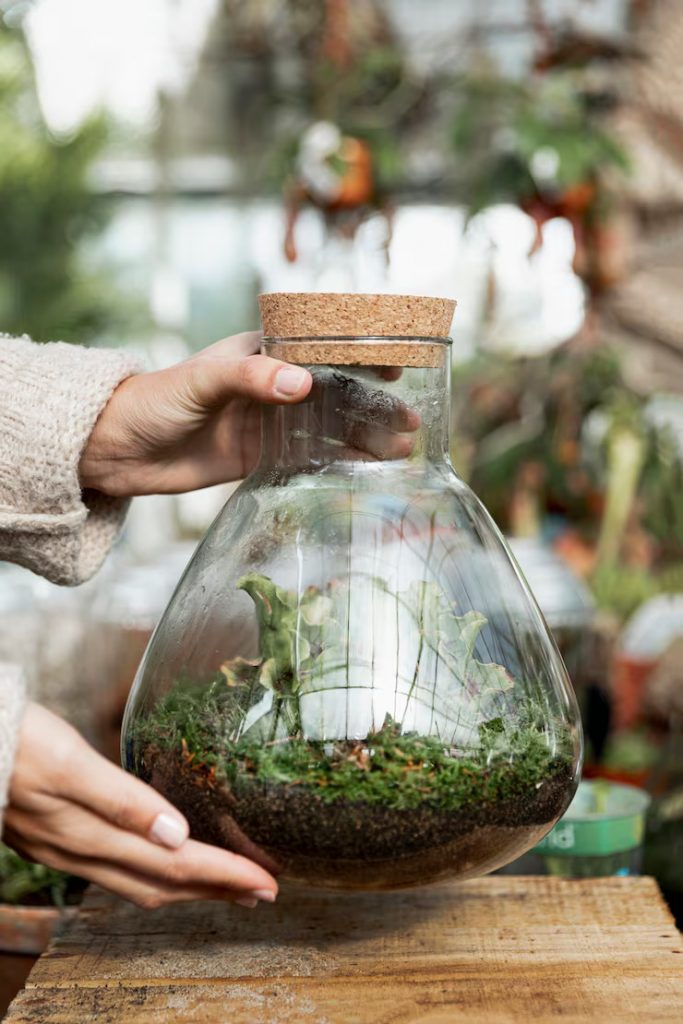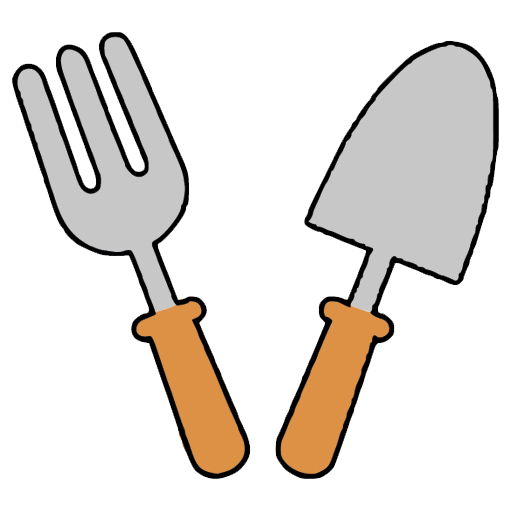Creating an indoor bottle garden is one of the easiest ways to build a tiny, self-contained world of plants. Once it is set up properly, this mini ecosystem almost looks after itself, with very little watering or maintenance needed.
In this guide, you’ll learn exactly how to choose the right bottle, layer the soil, pick suitable plants, and keep your indoor bottle garden healthy for years.
Contents
- 0.1 FAQs About Indoor Bottle Gardens
- 0.2 Final Thoughts on Creating an Indoor Bottle Garden
- 1 How to Make an Indoor Succulent Garden
What Is an Indoor Bottle Garden?
An indoor bottle garden (also called a closed terrarium) is a planted glass container with a lid or cork that traps moisture and creates its own humid microclimate.
Inside, water recycles through condensation and evaporation, so the plants need very little input from you once everything is balanced.
Bottle gardens are ideal if you:
Like low-maintenance plant setups
Want something decorative for a desk, shelf, or side table
Enjoy moss, ferns, and small tropical plants that love humidity
If you enjoy this kind of contained planting, you might also like making a moss-based display. For more ideas, see our guide on How to Make an Indoor Moss Garden.
Best Bottles and Containers for Indoor Bottle Gardens
Almost any clear glass container can work, as long as you can fit soil and plants inside.
Good options include:
Large glass bottles with a narrow neck
Demijohns or carboys
Purpose-made terrarium bottles
Large jars with corks or clip-top lids
Things to look for:
Clear glass (not coloured) so plants get enough light
A stable base that won’t tip over easily
A removable stopper or lid so you can adjust moisture if needed
You can find ready-made bottle terrarium kits and large glass containers with corks on Amazon if you do not have a suitable bottle at home.
Materials You’ll Need
Prepare everything before you start so you can build the garden in one go.
Glass bottle or terrarium with lid or cork
Small, humidity-loving plants (ferns, mosses, tiny tropical plants)
Potting compost suitable for houseplants
Drainage material (fine gravel or small stones)
Activated charcoal (helps keep the environment fresh)
Long-handled tweezers or planting tools
Small funnel or homemade scoop
Spray bottle with clean water
Optional: decorative stones, bark, or miniature ornaments

Step-by-Step: How to Create an Indoor Bottle Garden
Follow these steps slowly and carefully. Bottle gardens are easiest when you set them up properly from the start.
1. Clean and Dry the Bottle
Wash the bottle thoroughly with warm, soapy water and rinse well. Let it dry completely.
This helps:
Remove any residues that could encourage mould
Give you clear glass so the display looks sharp
If the neck is narrow, use a bottle brush or roll up a microfibre cloth on a stick to reach inside.
2. Add a Drainage Layer
Because there are no drainage holes, you need a base layer that stops roots from sitting in water.
Add 1–2 cm of clean gravel, pebbles, or fine stones
Sprinkle a thin layer of activated charcoal over the stones
The gravel helps excess water settle away from roots. The charcoal absorbs smells and reduces the risk of mould.
3. Add the Soil Layer
Next, add your potting compost.
Aim for 3–6 cm of soil, depending on bottle size
Use a peat-free houseplant mix or a mix of compost with a little perlite
Avoid very heavy garden soil, which compacts too much in enclosed containers
You can use a small funnel or folded piece of card to pour soil neatly into narrow-neck bottles.

4. Choose the Right Plants
Bottle gardens suit small plants that enjoy constant humidity and moderate, indirect light.
Good choices include:
Miniature ferns
Fittonia (nerve plant)
Mosses
Baby’s tears (Soleirolia)
Small, shade-loving tropicals
Avoid:
Cacti and succulents (they prefer drier conditions)
Fast-growing plants that will quickly outgrow the space
Look for small plug plants or cuttings – they’re easier to arrange and will adapt to the bottle more quickly.
5. Plant Carefully Inside the Bottle
Planting inside a narrow container is fiddly, so take your time.
Use long-handled tweezers or terrarium tools to place each plant
Start with the tallest plant at the back or centre
Add smaller plants around it to build layers and interest
Gently firm the soil around each root ball with a tool handle or spoon
Try not to press too hard: you want roots to make contact with the soil, but not compact it completely.
You can find terrarium tool sets with tweezers, rakes, and spades on Amazon that are designed specifically for bottle gardens and enclosed containers.
6. Add Decorative Finishing Touches
Once the plants are in place, add details that make the miniature landscape feel complete:
Small decorative stones or gravel paths
Pieces of bark or driftwood
Tiny figurines or ornaments if you like a themed look
Keep decorations minimal so plants still have space to grow.

7. Water and Seal the Bottle
Use a spray bottle to lightly mist the soil and plants.
Aim for evenly moist soil, not soggy
You should not see water pooling at the bottom; a little condensation on the glass is normal
Once the soil is damp, seal the bottle with the lid or cork. Over the next few days, you should see:
Light condensation in the morning that fades later in the day
Plants staying fresh and upright
If the glass is heavily misted all the time, you have too much water. Open the bottle for a few hours or a day to let moisture escape.
Where to Put Your Indoor Bottle Garden
Position your bottle garden where it gets:
Bright, indirect light
No harsh midday sun directly on the glass
A stable temperature away from radiators or heat sources
Direct sunlight can overheat the air inside the bottle and scorch plants quickly.
For more general advice on bottle gardens and terrariums, you can see the RHS guidance on terrariums and bottle gardens, which explains ideal light and care conditions for these mini ecosystems.
Simple Maintenance Tips
Bottle gardens are low-maintenance, but not completely maintenance-free. Check them every week or two.
Key jobs:
Monitor condensation:
Light misting is good
Heavy droplets running down the glass = too wet → open for a short time
Trim overgrown plants:
Snip back any stems hitting the glass
Remove yellow or rotting leaves as soon as you see them
Watch for pests:
Look for tiny insects on leaves or soil
If needed, remove the plant and treat separately before replanting
With care, a well-balanced bottle garden can last for years without being completely replanted.
FAQs About Indoor Bottle Gardens
How often do you water an indoor bottle garden?
If the bottle is truly closed and balanced, you may only need to water once every few months, or even less. Let condensation and plant condition guide you instead of a strict schedule.
Can you open the bottle garden sometimes?
Yes. If there is too much moisture or you need to trim plants, open it for a few hours or a day. Just avoid leaving it open permanently, or it will behave more like a regular pot.
What if mould appears inside the bottle?
Remove any mouldy leaves or decorations, reduce watering, and leave the lid off for a short time to dry the environment slightly. Activated charcoal in the base layer also helps keep things fresh.
Final Thoughts on Creating an Indoor Bottle Garden
An indoor bottle garden is a compact way to enjoy a lush, green landscape on a shelf or desk, without adding another high-maintenance plant to your routine. By choosing the right container, building solid drainage and soil layers, and picking plants that love humidity, you can create a self-contained ecosystem that looks after itself most of the time.
Once you’ve made one successfully, you can experiment with different shapes, themes, and plant combinations to build more miniature worlds.
Related Articles
BRING MORE MINI GARDENS INTO YOUR HOME
How to Make an Indoor Succulent Garden
Create a low-maintenance, sun-loving display to complement your bottle garden and style your space beautifully.

